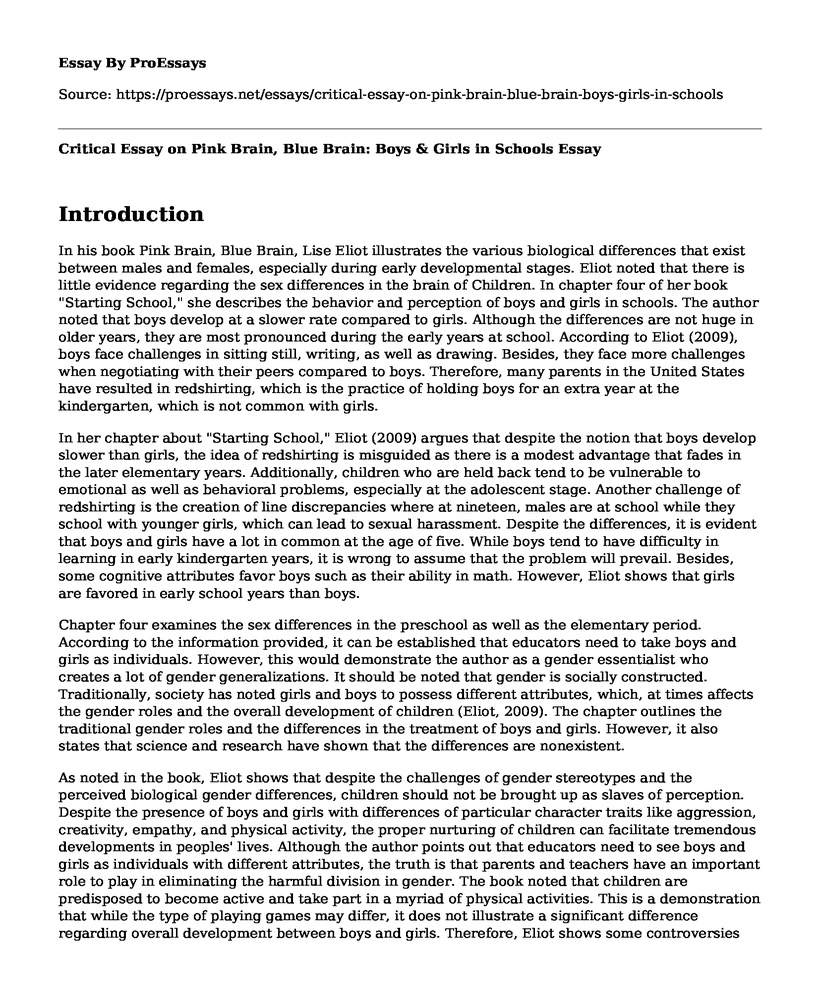Introduction
In his book Pink Brain, Blue Brain, Lise Eliot illustrates the various biological differences that exist between males and females, especially during early developmental stages. Eliot noted that there is little evidence regarding the sex differences in the brain of Children. In chapter four of her book "Starting School," she describes the behavior and perception of boys and girls in schools. The author noted that boys develop at a slower rate compared to girls. Although the differences are not huge in older years, they are most pronounced during the early years at school. According to Eliot (2009), boys face challenges in sitting still, writing, as well as drawing. Besides, they face more challenges when negotiating with their peers compared to boys. Therefore, many parents in the United States have resulted in redshirting, which is the practice of holding boys for an extra year at the kindergarten, which is not common with girls.
In her chapter about "Starting School," Eliot (2009) argues that despite the notion that boys develop slower than girls, the idea of redshirting is misguided as there is a modest advantage that fades in the later elementary years. Additionally, children who are held back tend to be vulnerable to emotional as well as behavioral problems, especially at the adolescent stage. Another challenge of redshirting is the creation of line discrepancies where at nineteen, males are at school while they school with younger girls, which can lead to sexual harassment. Despite the differences, it is evident that boys and girls have a lot in common at the age of five. While boys tend to have difficulty in learning in early kindergarten years, it is wrong to assume that the problem will prevail. Besides, some cognitive attributes favor boys such as their ability in math. However, Eliot shows that girls are favored in early school years than boys.
Chapter four examines the sex differences in the preschool as well as the elementary period. According to the information provided, it can be established that educators need to take boys and girls as individuals. However, this would demonstrate the author as a gender essentialist who creates a lot of gender generalizations. It should be noted that gender is socially constructed. Traditionally, society has noted girls and boys to possess different attributes, which, at times affects the gender roles and the overall development of children (Eliot, 2009). The chapter outlines the traditional gender roles and the differences in the treatment of boys and girls. However, it also states that science and research have shown that the differences are nonexistent.
As noted in the book, Eliot shows that despite the challenges of gender stereotypes and the perceived biological gender differences, children should not be brought up as slaves of perception. Despite the presence of boys and girls with differences of particular character traits like aggression, creativity, empathy, and physical activity, the proper nurturing of children can facilitate tremendous developments in peoples' lives. Although the author points out that educators need to see boys and girls as individuals with different attributes, the truth is that parents and teachers have an important role to play in eliminating the harmful division in gender. The book noted that children are predisposed to become active and take part in a myriad of physical activities. This is a demonstration that while the type of playing games may differ, it does not illustrate a significant difference regarding overall development between boys and girls. Therefore, Eliot shows some controversies regarding the management of boys and girls in preschool, as the differences pointed out are irrelevant in the overall development in preschool and elementary school.
References
Eliot, L. (2009). Pink brain, blue brain: How small differences grow into troublesome gaps--and what we can do about it. Boston: Houghton Mifflin Harcourt.
Cite this page
Critical Essay on Pink Brain, Blue Brain: Boys & Girls in Schools. (2023, Feb 22). Retrieved from https://proessays.net/essays/critical-essay-on-pink-brain-blue-brain-boys-girls-in-schools
If you are the original author of this essay and no longer wish to have it published on the ProEssays website, please click below to request its removal:
- Philosophical Theories on Poverty Alleviation Essay
- Discrimination and Fair Treatment of Women in the Workplaces - Paper Example
- Substance Abuse Support Programs - Essay Sample
- Do Student Loans Lead to Higher Tuition and Reckless Use of Funds? Essay
- Essay on Improving Writing Power: Language Power Tutorials for Students
- Gaining Teaching Skills: Reflective Practice & Experiential Learning - Essay Sample
- Essay Example on End Racial Segregation: Fedearal Government Actions to Solve Racism







